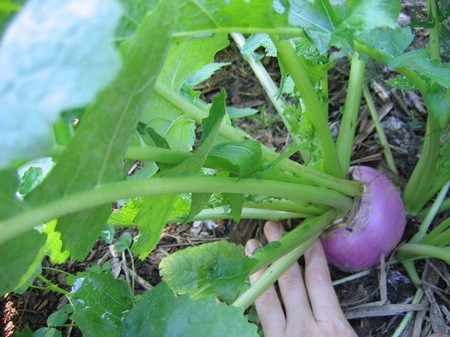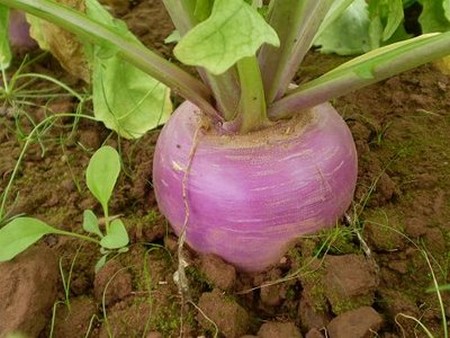Like swedes (rutabagas or yellow turnips), turnips are members of the cabbage family. The origins of the turnip go buck so far that they are obscure, but the wild plant from which it is derived is still commonly found throughout Europe and Asia and is thought to have been cultivated as far back as prehistoric times. The long history has meant that many forms have appeared in cultivation, particularly in China and Japan The popularity of the turnip has waned in the West, and with it a number of different forms, although there are still some 30 varieties from which to choose.
The Western form of the turnip is round, sometimes an almost perfect globe, sometimes slightly flattened. It has one thickish root or several roots emerging from the base. The skins are a creamy white, and the top of the globe can be green, purple, white or creamy-yellow. The flesh is white or yellowish. The globe is partly sunk into the ground, but most of it is above ground. In Asia long-rooted varieties are also grown, and seed of this form is sometimes available in the West, it is also possible sometimes to find old European varieties with long roots.
The fleshy ball is cooked and eaten, but many gardeners also enjoy the young leaves, which are cooked as spring greens. Summer turnips are more succulent and lend themselves to a range of dishes. Those that are overwintered are generally not quite as tender, but they Lire useful in casseroles, stews and soups. In Japan they are often eaten raw.
Cultivation
Because turnips are a member of the brassica family, they should be included with cabbages in the rotational sequence. They need an open, sunny situation and, preferably, a light soil, although they can be grown in heavier ground. There must be plenty of organic material in the soil so that it does not dry out. The manure should either be left from a previous crop or be dug in during the previous autumn.
Sow early varieties of turnip under cloches in late winter for early crops or in open ground from early spring onwards. Sow seed 1 cm deep in drills 23cm apart. When the seedlings are big enough to handle, thin them to about 13cm apart. Continue to sow at two-to three-week intervals for a continuous supply of small, tender turnips throughout the summer. For varieties to be harvested from the autumn and winter, sow in midsummer. They should be at the same depth, but rows should be about 30cm apart. Thin the seedlings to 20cm.
It you want to grow turnips just as “greens”, sow thinly in late summer and there should be no need to thin. Rows can be as close as 8—l0cm.
Harvesting
Harvest the early and summer varieties as soon as they are the size of golf balls. They can be eaten when they are slightly larger, but they are at their best at this size. Larger and older turnips become woody, so rather than sowing one long row. It is better to sow short rows at different times to provide a steady supply of young turnips. Varieties sown in midsummer can be harvested from autumn onwards as they are required. The “greens” can be harvested as young leaves from spring into summer.
Storage
Turnips can be left in the ground until they are required. In very cold areas or if they are likely to be frozen in the ground and impossible to extract, they can be lifted, the tops removed and the globes stored in trays of just-moist sand or peat (peat moss), and kept in a frost-free place.
Pests and diseases
Turnips suffer from the same problems as cabbages. Flea beetle, which is likely to be the worst pest, should be treated with derris dust.
Diseases can include violet root rot and club root. Destroy any affected plants.

